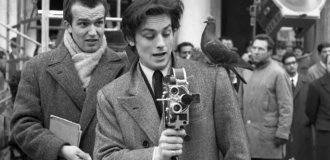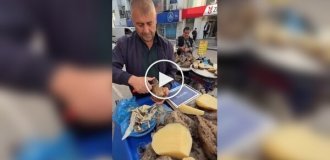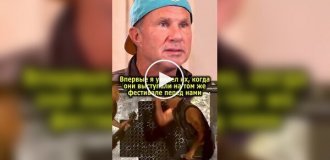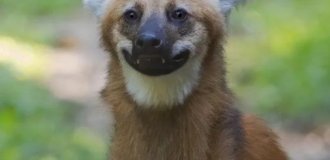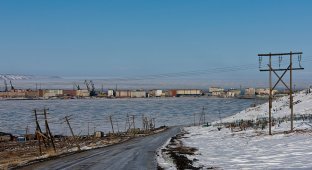Chukotka. Anadyr and surrounding area (photo + text)
The extreme northeast of Russia is the Chukotka Autonomous Okrug with its administrative center in the city of Anadyr. The most remote territory from central Russia. Further, through the Bering Strait it is Alaska - America.

The only possible way to get to Chukotka is by plane. The existing sea communication during the summer navigation season is used only for the delivery of goods. There is no passenger service due to the long length of sea routes. In principle, there are no railway or road connections with the “mainland”.

The distance from Moscow to Anadyr is approximately 6400 km. The flight takes place in an arc above the Arctic Circle. If you fly during the day, then from the window you can see the tundra stretching for many kilometers along the entire road.
Currently, only one airline operates regular flights from Moscow to Chukotka - Transaero. You can get from Khabarovsk to Anadyr by planes of the Vladivostok Air company. All. There is no more message!

Despite the significant cost of tickets (20 thousand rubles), all planes are almost 100% loaded.
It should be noted that even by plane it is not always possible to get to Anadyr. Due to unstable weather prone to rain, snow and strong winds, flights may be delayed or completely cancelled. During certain periods in spring and autumn, planes do not fly at all.
The entire territory of the Chukotka Autonomous Okrug is a border zone with appropriate entry rules. Border guards meet those arriving already on the plane. If you do not have local registration, you must have a reason to enter. For example, an invitation from someone or a travel certificate. Passengers who do not bother with documents are sent back on the same plane without ever setting foot on the soil of Chukotka.

Anadyr Airport in the village "Ugolnye Pi" is located on the opposite side of the Anadyr Estuary. In the summer season, you can get from the city to the airport by boat. The fare is 400 rubles. There is also such an exotic type of transport in our country - a hovercraft. If you want to travel in comfort, then by paying the taxi drivers a certain amount of money, you will be taken to your place directly by car. The cars are loaded onto a barge, which transports them to the other side. The downside of this method is that you won’t be able to admire the sea views on the road. The sides of the barge are very high, and getting out of the car is problematic. They are placed very close to each other.


In winter and off-season, the only way to communicate is by helicopter. The ticket price is about 1500 rubles. When the ice freezes enough, vehicles are allowed to cross it. But due to the danger of this route, the ice crossing does not always work.
Anadyr welcomes you with clean, almost perfect roads and sidewalks. The houses are painted in cheerful colors. There are lawns all around, benches, trash cans, etc. are placed.

The ends of the houses are decorated with stylized posters depicting elements of Chukchi life - deer, shamanic drums, red caviar. All this is called “Chukchi artika”. You can feel the hand of a professional designer. On each poster, along with the Russian name, there is an inscription in the Chukchi language.

What do you think the bear is called in Chukchi? "Umk`y". Do you remember the famous cartoon about Umka? The deer is called “K,orans” and so on. Apparently all this is intended to preserve the traditional Chukchi culture and language.

The city makes a much more pleasant impression than most Russian cities. All this is the merit of Roman Abramovich. Anadyr before Abramovich and after are two different cities. Gray, dirty, gloomy before and bright, modern, well-groomed after.

Absolutely all buildings in the city are on stilts. Anadyr is located in a permafrost zone and construction using traditional methods is impossible here.

Permafrost is a layer of earth ranging from several tens to several hundred meters thick, the temperature of which has not risen above zero degrees for thousands of years. The foundation of a conventional building will heat the soil, causing it to melt and spread. Such a building will be unstable or even crack and fall.
For buildings standing on stilts, there remains a significant distance between the ground floor level and the ground. It serves to remove heat from the building. Thus, the soil is always frozen. Piles in such soil feel even better than in ordinary soil.
All communications are also carried out on the surface.


The central square of Anadyr - Lenin Square - is located on the elevated bank of the Anadyr estuary. The museum center "Heritage of Chukotka" is located on the square. The building itself is of very unusual architecture. Everything inside is done with the latest technology. On three floors there is an exhibition telling about the stages of development of Chukotka and the life of its indigenous inhabitants. On the ground floor there is a multimedia room. There is a concert hall in the same building.


Near the square is the Cathedral of the Life-Giving Trinity. The cathedral is the largest wooden church in Russia, built on permafrost, and the only cathedral in Chukotka. Like all buildings in Anadyr, the temple stands on stilts. The soil underneath is cooled by refrigeration units in the summer.

Not far from the cargo port there is a memorial “The First Revolutionary Committee of Chukotka”, opened in 1981.
The outskirts of Anadyr are huge tundra expanses with hills rising among them. The closest to the city are St. Michael’s Hill with an abandoned tropospheric communication station located on it, about 5-7 kilometers away, as well as St. Dionysius Mount, 50 km away. From almost anywhere in the city there is a magnificent view of these hills or the mountains located on the other side of the estuary. The city itself, also located on a hill, extends from its top to the waters of the Anadyr Estuary.

The road transport system in Chukotka is underdeveloped. And if on the side of the village of Coal Mines there is some kind of road network, then on the city side there are practically no roads. Those. in the city itself, of course, everything is in order, but immediately after it everything ends. Several primers of rather mediocre quality reach the tundra. But they also end pretty soon. It is impossible to reach any populated areas using them.


The flora of the surrounding area of Anadyr is characterized by the complete absence of any trees. Unless, of course, you count their dwarf brothers. For example, there is a dwarf pine that literally spreads along the ground, and is even lower in height than many shrubs.

Towards the end of summer, the berry ripening season begins in the tundra. Lingonberries, blueberries, blueberries, shiksha (dropsy) - this is an incomplete list of what the tundra is rich in. In addition to berries, the tundra has a lot of different mushrooms. Just as we, residents of the middle zone, follow them into the forest, so the local population goes to the tundra to pick mushrooms and berries.

What is the tundra? This is usually a wetland covered with low bushes and grass. It is impossible to move along it in a car, even with cross-country ability.

The ideal means of transportation are various vehicles with reduced pressure wheels. Due to the low pressure on the ground, they do not fall into swamps. In addition, they move across the tundra on tracked all-terrain vehicles, leaving deep and long-lasting tracks.

The tundra in the vicinity of Anadyr is a monument to human mismanagement. A lot of rusty barrels, the remains of some mechanisms and machines that have remained here forever. The pinnacle of this is the abandoned tropospheric communication station on St. Michael's Hill. The most grandiose building!

It is necessary to say a few words separately about the tropospheric communication system. The system was created in the late 60s in order to provide communications to the regions of the far north.

The vast distance, permafrost and harsh climate did not allow laying cables. Conventional VHF communications operate at a distance of no more than 80 km. Satellite communications at that time were still poorly developed.



Therefore, the Horizon tropospheric over-the-horizon communication system was developed. Range 250 -425 km. The principle of operation of this system is the property of reflection of radio waves from the upper layers of the atmosphere. The problem was that the reflected signal was very weak, and it could shift significantly.

To solve the above problems and ensure a long communication range, it was necessary to build giant antennas with mirror dimensions of 20x20 meters, or 30x30 meters. Two antennas for each direction.

And so, at the top of St. Michael’s Hill there are six huge antennas (the station worked in 3 directions) and several smaller ones related to some other communication system. This is the former Yukon station - part of the Sever tropospheric radio relay link (TRRL). The station is equipped with diesel generator sets and could operate autonomously for a long time.
A network of such stations was located along the Arctic Circle throughout the northern USSR.
With the development of satellite communication systems, TRRL began to be significantly inferior to them. Ultimately, the system was finally closed in the late 90s. Yukon Station ceased operation in 2003.
Now only the wind blows among the antennas, technical buildings, and cables that are beginning to rust. One of the antennas has already fallen, the others are still standing. A few more years will pass and the rest will not withstand the pressure of the elements, burying the memory of one of the most ambitious projects of the USSR.
When talking about Chukotka, one cannot fail to mention one of its main riches. Along with gold, gas, oil, this is red caviar. Chum salmon spawning begins in August and ends in early September. This is the most fertile time for fishing.

They fish, of course, not with fishing rods, but with nets placed along the shore of the estuary. The Anadyr fish factory is engaged in procurement on an industrial scale. Everyone else needs to purchase a license to fish.

Fishing is prohibited on Monday and Tuesday. An exception is made for the indigenous people - the Chukchi. They will be happy to sell you both raw and already cooked caviar. It’s not worth buying ready-made caviar from them. It is completely unknown under what conditions it was prepared. But you can take raw caviar in eggs.

The egg is a thin but durable film that forms a shell bag in which the caviar of salmon and sturgeon fish is located. Raw caviar costs 300-350 rubles per kilogram. Feel the difference! In our stores, a kilogram of red caviar costs about 1,700 rubles. True, there will be slightly less finished caviar per kilogram of raw caviar, but nevertheless...

Making caviar is quite simple. The first thing you need to do is cook the brine. Brine is a solution of table salt, usually close to saturation. The water is brought to a boil and table salt is gradually added to it. You need to add it until it dissolves. Another way to check the readiness of brine is to use raw potatoes. If it does not sink in the solution, then the brine is ready.
Before salting, the caviar must be separated from the roe. This process is called screening. If there is not enough caviar, then you can get by with an ordinary spoon, but this is extremely inconvenient and not of very high quality. It is optimal to use a badminton racket. The nuts open and rub against the rocket, causing the eggs to separate and fall down.
After the screening is completed, the eggs need to be washed. This is done on gauze. That's it, now the caviar is ready for salting. We lower it into the brine for a period of 5 to 10 minutes. After drying for a short time, the caviar can be eaten or placed in jars.
The Chukchi often simply throw away the fish they catch during the spawning season, so if you need fish, they will happily give it to you completely free of charge. They themselves, of course, also prepare fish for themselves. The fish is cut and hung for drying in small sheds that literally litter the entire coastline near the village of Tavaivaam.

The village of Tavaivaam is, by and large, part of Anadyr. The indigenous population of Chukotka lives here. Panel houses were built especially for them. Therefore, in Anadyr now you will no longer see traditional Chukchi dwellers.

There is an opinion that the indigenous peoples of the north are now actively drinking themselves to death and degrading. I don’t know... Maybe it’s true, of course, but some kind of global process of degradation is imperceptible. No, of course, among the Chukchi there are those who actively abuse. At the same time, they look and live accordingly, of course. However, the majority, it seems to me, have perfectly integrated into the modern life of Anadyr and in their lifestyle do not differ at all from the Russian population.

One of the traditional folk crafts in Chukotka is bone carving. The jewelry made from walrus tusks is truly magnificent! Moreover, many are real works of art with a corresponding cost, which can reach up to 100 thousand rubles for individual copies! Expensive. Yes, it’s expensive, like all life in Chukotka. On average, food prices are at least twice as expensive as in Moscow. The cost of gasoline is 1.5 times higher!
This is due to the fact that the region exists solely on products and goods brought from the mainland. Once a year in the summer, during the northern sea delivery, the bulk of products and goods are delivered. Perishable products such as vegetables or fruits are delivered only by air. Their prices will shock an unprepared person.
Among their products, Chukotka only has venison, fish and caviar.


The last days of our stay in Anadyr please us with unusually warm weather. 20 degrees during the day and absolutely clear skies. This happens here very, very rarely. It’s as if Chukotka nature is saying goodbye to us, calling us to return to this infinitely amazing and harsh region.
